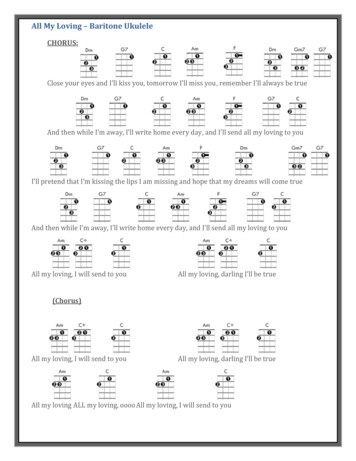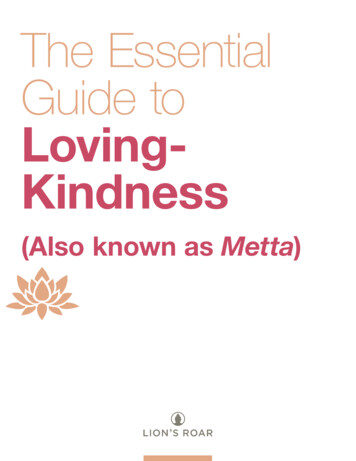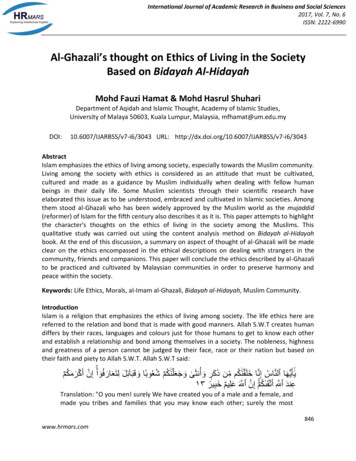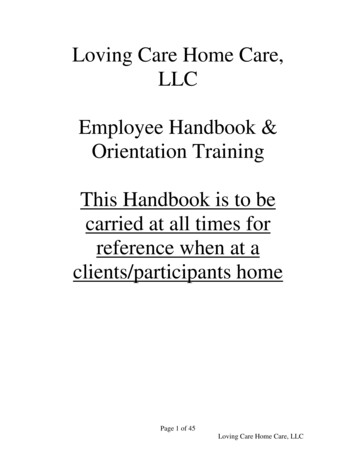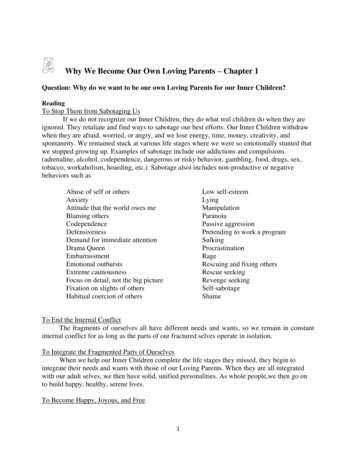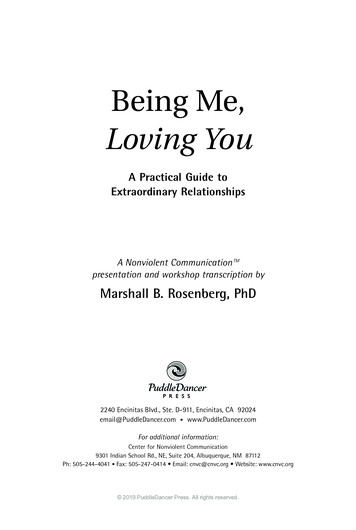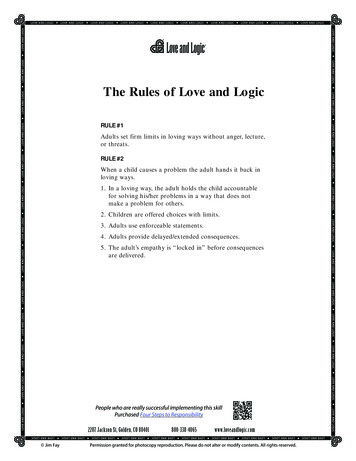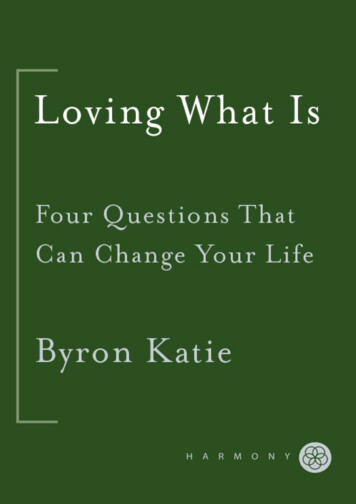
Transcription
Praise forLOVING WHAT IS“Good Lord! Where did Byron Katie come from? She’s the realMcCoy. Her work is amazingly effective—a simple, straight forward antidote to the suffering we unnecessarily create forourselves. She asks us to believe nothing, but provides asurprisingly effective and simple way to cut through the tangle ofdelusions we wrap ourselves in. Just reading the exchanges inLoving What Is, I can admit things I didn’t want to admit andstop torturing my self in ways I didn’t realize I was doing.”—David Chadwick, author of Crooked Cucumber: The Life andZen Teaching of Shunryu Suzuki“Suppose you could find a simple way to embrace your life withjoy, stop arguing with reality, and achieve serenity in the midst ofchaos. That is what Loving What Is offers. It is no less than arevolutionary way to live your life. The question is: Are we braveenough to accept it?”—Erica Jong, author of Fear of Flying“Loving What Is is filled with the essence of wisdom. Katie’sWork is a wonderful, transformative practice for anyoneinterested in spiritual growth.”—Lama Surya Das, author of Awakening the Buddha Within“Byron Katie’s Work is a great blessing for our planet. The rootcause of suffering is identification with our thoughts, the ‘stories’that are continuously running through our minds. Byron Katie’sWork acts like a razor-sharp sword that cuts through that illusionand enables you to know for yourself the timeless essence ofyour being. Joy, peace, and love emanate from it as your naturalstate. In Loving What Is, you have the key. Now use it.”—Eckhart Tolle, author of The Power of Now
OceanofPDF.com
OceanofPDF.com
Copyright 2002 by Byron Kathleen MitchellAll rights reserved. No part of this book may be reproduced or transmitted in any form orby any means, electronic or mechanical, including photocopying, recording, or by anyinformation storage and retrieval system, without permission in writing from the publisher.Published in the United States by Harmony Books, an imprint of the Crown PublishingGroup, a division of Penguin Random House LLC, New York.crownpublishing.comHARMONY BOOKS is a registered trademark, and the Circle colophon is a trademark ofPenguin Random House LLC.Originally published in hardcover by Harmony Books, an imprint of the Crown PublishingGroup, a division of Penguin Random House LLC, New York, in 2002, and subsequentlypublished in paperback by Three Rivers Press, an imprint of the Crown Publishing Group,a division of Penguin Random House LLC, New York, in 2003.eBook design adapted from printed book design by David BullenLibrary of Congress Cataloging-in-Publication Data Katie, Byron.Loving what is : four questions that can change your life / the work of Byron Katie;written with Stephen Mitchell. 1. Self-actualization (Psychology) 2. Self-acceptance. I.Mitchell, Stephen, 1943– II. Title.BF637.S4 K336 2003158.1—dc21 20020108529781400045372eBook ISBN 9781400045464ISBNv4.1 r1aOceanofPDF.com
To Adam Joseph Lewisand to MichaelOceanofPDF.com
ContentsCoverTitle PageCopyrightDedicationIntroduction by Stephen MitchellHow to Read This Book1.2.3.4.A Few Basic PrinciplesThe Great UndoingEntering the DialoguesDoing The Work on Couples and Family LifeI Want My Son to Talk to MeMy Husband’s AffairThe Baby Shouldn’t ScreamI Need My Family’s Approval5. Deepening Inquiry6. Doing The Work on Work and MoneyHe’s So Incompetent!Uncle Ralph and His Stock TipsAngry at Corporate America7. Doing The Work on Self-JudgmentsAfraid of Life8. Doing The Work with Children9. Doing The Work on Underlying BeliefsShe Was Supposed to Make Me HappyI Need to Make a Decision10. Doing The Work on Any Thought or Situation11. Doing The Work on the Body and AddictionsAn Unhealthy Heart?My Daughter’s Addiction12. Making Friends with the Worst That Can HappenAfraid of DeathBombs Are FallingMom Didn’t Stop the Incest
I’m Angry at Sam for DyingTerrorism in New York City13. Questions and Answers14. The Work in Your LifeAppendix: Self-FacilitationContact InformationAbout the AuthorsOceanofPDF.com
IntroductionThe more clearly you understand yourself and your emotions, the more you become alover of what is.Baruch SpinozaThe first time I watched The Work, I realized that I was witnessing somethingtruly remarkable. What I saw was a succession of people, young and old,educated and uneducated, who were learning to question their own thoughts,the thoughts that were most painful to them. With the lovingly incisive help ofByron Katie (everyone calls her Katie), these people were finding their waynot only toward the resolution of their immediate problems, but also toward astate of mind in which the deepest questions are resolved. I have spent a goodpart of my life studying and translating the classic texts of the great spiritualtraditions, and I recognized something very similar in process here. At thecore of these traditions— in works such as the Book of Job, the Tao Te Ching,and the Bhagavad Gita—there is an intense questioning about life and death,and a profound, joyful wisdom that emerges as an answer. That wisdom, itseemed to me, was the place Katie was standing in, and the direction wherethese people were headed.As I watched from my seat in a crowded community center, five men andwomen, one after another, were learning freedom through the very thoughtsthat had caused their suffering, thoughts such as “My husband betrayed me”or “My mother doesn’t love me enough.” Simply by asking four questionsand listening to the answers they found inside themselves, these people wereopening their minds to profound, spacious, and life-transforming insights. Isaw a man who had been suffering for decades from anger and resentmenttoward his alcoholic father light up before my eyes within forty-five minutes.I saw a woman who had been almost too frightened to speak, because she hadjust found out that her cancer was spreading, end the session in a glow ofunderstanding and acceptance. Three out of the five people had never doneThe Work before, yet the process didn’t seem to be more difficult for themthan it was for the other two, nor were their realizations any less profound.
They all began by realizing a truth so basic that it is usually invisible: the factthat (in the words of the Greek philosopher Epictetus) “we are disturbed notby what happens to us, but by our thoughts about what happens.” As soon asthey grasped that truth, their whole understanding changed.Before people have experienced The Work of Byron Katie for themselves,they often think that it is too simple to be effective. But its simplicity isprecisely what makes it so effective. Over the past two years, since Katie andI met (we are now married), I have done The Work many times, on thoughts Ihadn’t even been aware of. And I’ve watched more than a thousand people doit in public events across the United States and Europe, on the whole gamut ofhuman problems: from major illnesses, the deaths of parents and children,sexual and psychological abuse, addictions, financial insecurity, professionalproblems, and social issues to the usual frustrations of daily life. Again andagain, I have seen The Work quickly and radically transform the way peoplethink about their problems. And as the thinking changes, the problemsdisappear.“Suffering is optional,” Katie says. Whenever we experience a stressfulfeeling—anything from mild discomfort to intense sorrow, rage, or despair—we can be certain that there is a specific thought causing our reaction, whetheror not we are conscious of it. The way to end our stress is to investigate thethinking that lies behind it, and anyone can do this by himself with a piece ofpaper and a pen. The Work’s four questions, which you will see in contextlater in this introduction, reveal where our thinking isn’t true for us. Throughthis process — Katie also calls it “inquiry”—we discover that all the conceptsand judgments that we believe or take for granted are distortions of things asthey really are. When we believe our thoughts instead of what is really truefor us, we experience the kinds of emotional distress that we call suffering.Suffering is a natural alarm, warning us that we’re attaching to a thought;when we don’t listen, we come to accept this suffering as an inevitable part oflife. It’s not.The Work has striking similarities with the Zen koan and the Socraticdialogue. But it doesn’t stem from any tradition, Eastern or Western. It isAmerican, homegrown, and mainstream, having originated in the mind of anordinary woman who had no intention of originating anything.
To realize your true nature, you must wait for the right moment and the rightconditions. When the time comes, you are awakened as if from a dream. Youunderstand that what you have found is your own and doesn’t come from anywhereoutside.Buddhist SutraThe Work was born on a February morning in 1986 when Byron KathleenReid, a forty-three-year-old woman from a small town in the high desert ofsouthern California, woke up on the floor of a halfway house.In the midst of an ordinary life—two marriages, three children, a successfulcareer—Katie had entered a ten-year-long downward spiral into rage,paranoia, and despair. For two years she was so depressed that she couldseldom manage to leave her house; she stayed in bed for weeks at a time,doing business by telephone from her bedroom, unable even to bathe or brushher teeth. Her children would tiptoe past her door to avoid her outbursts ofrage. Finally, she checked in to a halfway house for women with eatingdisorders, the only facility that her insurance company would pay for. Theother residents were so frightened of her that she was placed alone in an atticroom.One morning, a week or so later, as she lay on the floor (she had beenfeeling too unworthy to sleep in a bed), Katie woke up without any conceptsof who or what she was. “There was no me,” she says.All my rage, all the thoughts that had been troubling me, my whole world, the wholeworld, was gone. At the same time, laughter welled up from the depths and just pouredout. Everything was unrecognizable. It was as if something else had woken up. Itopened its eyes. It was looking through Katie’s eyes. And it was so delighted! It wasintoxicated with joy. There was nothing separate, nothing unacceptable to it; everythingwas its very own self.When Katie returned home, her family and friends felt that she was adifferent person. Her daughter, Roxann, who was sixteen at the time, says,We knew that the constant storm was over. She had always yelled at me and mybrothers and criticized us; I used to be scared to be in the same room with her. Now sheseemed completely peaceful. She would sit still for hours on the window seat or out inthe desert. She was joyful and innocent, like a child, and she seemed to be filled withlove. People in trouble started knocking on our door, asking her for help. She’d sit withthem and ask them questions—mainly, “Is that true?” When I’d come home miserable,with a problem like “My boyfriend doesn’t love me anymore,” Mom would look at meas if she knew that wasn’t possible, and she’d ask me, “Honey, how could that betrue?” as if I had just told her that we were living in China.Once people understood that the old Katie wasn’t coming back, they beganto speculate about what had happened to her. Had some miracle occurred?
She wasn’t much help to them: It was a long time before she could describeher experience intelligibly. She would talk about a freedom that had woken upinside her. She also said that, through an inner questioning, she had realizedthat all her old thoughts were untrue.Shortly after Katie got back from the halfway house, her home began to fillwith people who had heard about her and had come to learn. She was able tocommunicate her inner inquiry in the form of specific questions that anyonewho wanted freedom could apply on his own, without her. Soon she began tobe invited to meet with small gatherings in people’s living rooms. Her hostsoften asked her if she was “enlightened.” She would answer, “I’m justsomeone who knows the difference between what hurts and what doesn’t.”In 1992 she was invited to northern California, and The Work spread veryfast from there. Katie accepted every invitation. She has been on the roadalmost constantly since 1993, demonstrating The Work in church basements,community centers, and hotel meeting rooms, in front of small and largeaudiences. And The Work has found its way into all kinds of organizations,from corporations, law firms, and therapists’ offices to hospitals, prisons,churches, and schools. It is now popular in other parts of the world whereKatie has traveled. All across America and Europe, there are groups of peoplewho meet regularly to do The Work.Katie often says that the only way to understand The Work is to experienceit. But it’s worth noting that inquiry fits precisely with current research intothe biology of mind. Contemporary neuroscience identifies a particular part ofthe brain, sometimes called “the interpreter,” as the source of the familiarinternal narrative that gives us our sense of self. Two prominentneuroscientists have recently characterized the quirky, undependable qualityof the tale told by the interpreter. Antonio Damasio describes it this way:“Perhaps the most important revelation is precisely this: that the left cerebralhemisphere of humans is prone to fabricating verbal narratives that do notnecessarily accord with the truth.” And Michael Gazzaniga writes: “The leftbrain weaves its story in order to convince itself and you that it is in fullcontrol .What is so adaptive about having what amounts to a spin doctor inthe left brain? The interpreter is really trying to keep our personal storytogether. To do that, we have to learn to lie to ourselves.” These insights,based on solid experimental work, show that we tend to believe our own pressreleases. Often when we think we’re being rational, we’re being spun by ourown thinking. That trait explains how we get ourselves into the painfulpositions that Katie recognized in her own suffering. The self-questioning shediscovered uses a different, less-known capacity of the mind to find a way out
of its self-made trap.After doing The Work, many people report an immediate sense of re leaseand freedom from thoughts that were making them miserable. But if TheWork depended on a momentary experience, it would be far less useful than itis. The Work is an ongoing and deepening process of self-realization, not aquick fix. “It’s more than a technique,” Katie says. “It brings to life, fromdeep within us, an innate aspect of our being.”The deeper you go into The Work, the more powerful you realize it is.People who have been practicing inquiry for a while often say, “The Work isno longer something I do. It is doing me.” They describe how, without anyconscious intention, the mind notices each stressful thought and undoes itbefore it can cause any suffering. Their internal argument with reality hasdisappeared, and they find that what remains is love —love for themselves,for other people, and for whatever life brings. The title of this book describestheir experience: Loving what is becomes as easy and natural as breathing.Considering that, all hatred driven hence,The [mind] recovers radical innocenceAnd learns at last that it is self-delighting,Self-appeasing, self-affrighting,And that its own sweet will is Heaven’s will.William Butler YeatsI have waited until now to introduce the four questions to you, because theydon’t make much sense out of context. The best way to meet them is to seehow they function in an actual example of The Work. You’ll also meet whatKatie calls the “turnaround,” which is a way of experiencing the opposite ofwhat you believe is true.The following dialogue with Katie took place before an audience of abouttwo hundred people. Mary, the woman who is sitting opposite Katie on thestage, has filled out a one-page Worksheet that asked her to write down herthoughts about someone who upsets her. The instructions are: “Allow yourselfto be as judgmental and petty as you really feel. Don’t try to be ‘spiritual’ orkind.” The pettier we can be when writing, the more likely it is that we’llbenefit from The Work. You’ll see that Mary hasn’t held back at all. She is aforceful woman, perhaps forty years old, slim, attractive, and dressed in
expensive-looking exercise clothes. At the beginning of the dialogue, heranger and impatience are palpable.A first experience of The Work, as a reader or onlooker, can beuncomfortable. It helps to remember that all the participants—Mary, Katie,and the audience—are on the same side here; all of them are looking for thetruth. If Katie ever seems to be mocking or derisive, you’ll realize, uponcloser examination, that she’s making fun of the thought that is causingMary’s suffering, never of Mary herself.Toward the middle of the dialogue, when Katie asks, “Do you really wantto know the truth?” she doesn’t mean her truth, or any abstract, predeterminedtruth, but Mary’s truth, the truth that is hidden behind her troubling thoughts.Mary has entered the dialogue in the first place because she trusts that Katiecan help her discover where she is lying to herself. She welcomes Katie’spersistence.You’ll also notice right away that Katie is very free in her use of terms ofendearment. One CEO, before a workshop that Katie gave to his topexecutives, felt that he had to issue a warning: “If she holds your hand andcalls you ‘sweetheart’ or ‘honey,’ please don’t get excited. She does this witheveryone.”—Mary [reading the statements from her Worksheet]: I hate my husbandbecause he drives me crazy—everything about him, including the way hebreathes. What disappoints me is that I don’t love him anymore, and ourrelationship is a charade. I want him to be more successful, to not want tohave sex with me, to get in shape, to get a life outside of me and the children,to not touch me anymore, and to be powerful. My husband shouldn’t foolhimself that he’s good at our business. He should create more success. Myhusband is a wimp. He’s needy and lazy. He’s fooling himself. I refuse tokeep living a lie. I refuse to keep living my relationship as an imposter.Katie: Does that pretty well sum it up? [The audience bursts into laughter,and Mary laughs along with them.] By the sound of the laughter, it seems asthough you speak for a lot of people in this room. So, let’s start at the top andsee if we can begin to understand what’s going on.Mary: I hate my husband because he drives me crazy— everything about him,including the way he breathes.Katie: “Your husband drives you crazy”—is it true? [This is the first of the
four questions: Is it true?]Mary: Yes.Katie: Okay. What’s an example of that, sweetheart? He breathes?Mary: He breathes. When we’re doing conference calls for our business, I canhear his breath on the other end of the telephone, and I want to scream.Katie: So, “His breath drives you crazy”—is that true?Mary: Yes.Katie: Can you absolutely know that that’s true? [The second question: Canyou absolutely know that it’s true?]Mary: Yes!Katie: We can all relate to that. I hear that it really is true for you. In myexperience, it can’t be your husband’s breath that’s driving you crazy; it has tobe your thoughts about his breath that are driving you crazy. So let’s take acloser look and see if that’s true. What are your thoughts about his breath onthe phone?Mary: That he should be more aware that he’s breathing loudly during aconference call.Katie: How do you react when you think that thought? [The third question:How do you react when you think that thought?]Mary: I feel like I want to kill him.Katie: So what’s more painful—the thought you attach to his breathing or hisbreathing?Mary: The breathing is more painful. I’m comfortable with the thought that Iwant to kill him. [Mary laughs, and so does the audience.]Katie: You can keep that thought. That’s the beautiful thing about The Work.You can keep all your thoughts.Mary: I’ve never done The Work before, so I don’t know any of the “right”answers.Katie: Your answers are perfect, sweetheart. Don’t rehearse. So he’s breathingon the phone and you have the thought that he should be more aware, and he’snot. What’s the next thought?
Mary: It brings up every terrible thought I have about him.Katie: Okay, and he’s still breathing. “He should stop breathing into thephone on the conference call”—what’s the reality of it? Does he?Mary: No. I’ve told him to stop.Katie: And he still does it. That’s reality. What’s true is always what’shappening, not the story about what should be happening. “He should stopbreathing on the phone”—is it true?Mary [after a pause]: No. It’s not true. He’s doing it. That’s what’s true.That’s reality.Katie: So how do you react when you think the thought that he should stopbreathing on the phone, and he doesn’t?Mary: How do I react? I want out. It feels uncomfortable because I know Iwant out and I know I’m not going anywhere.Katie: Let’s move back to inquiry, honey, rather than moving further intoyour story, your interpretation of what’s happening. Do you really want toknow the truth?Mary: Yes.Katie: Okay. It helps if we stick to one written statement at a time. Can yousee a reason to drop the thought that he should stop breathing on the phone?[This is an additional question that Katie sometimes asks.] For those of younew to The Work, if you hear that I’m asking Mary to drop her story, let memake it very clear: I’m not. This is not about getting rid of thoughts or aboutovercoming, improving, or surrendering them. None of that. This is aboutrealizing for yourself internal cause and effect. The question is simply “Canyou see a reason to drop this thought?”Mary: Yes, I can. It would be a lot more enjoyable to do conference callswithout this thought.Katie: That’s a good reason. Can you find a stress-free reason to keep thisthought, this lie, that he should stop breathing on the phone? [A secondadditional question]Mary: No.Katie: Who would you be without that thought? [The fourth question: Who
would you be without the thought?] Who would you be, while you’re on aconference call with your husband, if you didn’t have the ability to think thatthought?Mary: I’d be much happier. I’d be more powerful. I wouldn’t be distracted.Katie: Yes, sweetheart. That’s it. It’s not his breathing that is causing yourproblem. It’s your thoughts about his breathing, because you haven’tinvestigated them to see that they oppose reality in the moment. Let’s look atyour next statement.Mary: I don’t love him anymore.Katie: Is that true?Mary: Yes.Katie: Okay. Good. I hear that, and do you really want to know the truth?Mary: Yes.Katie: Okay. Be still. There’s no right or wrong answer. “You don’t lovehim”—is that true? [Mary is silent.] If you had to answer honestly either yesor no, right now, and you had to live forever with your answer—your truth oryour lie—what would your answer be? “You don’t love him”—is that true?[There is a long pause. Then Mary begins to cry.]Mary: No. It’s not true.Katie: That’s a very courageous answer. If we answer it that way, with what’sreally true for ourselves, we think that there may be no way out. “Is it true?”is just a question! We’re terrified to answer the simplest question honestly,because we project what that may mean in the imagined future. We think wehave to do something about it. How do you react when you believe thethought that you don’t love him?Mary: It makes my whole life a stupid charade.Katie: Can you see a reason to drop this thought that you don’t love him?And I’m not asking you to drop the thought.Mary: Yes, I can see a reason to drop it.Katie: Can you think of one stress-free reason to keep the thought?Mary [after a long pause]: I think if I keep my story, then I can keep him from
wanting to have sex all the time.Katie: Is that a stress-free reason? It seems stressful to me.Mary: I guess it is.Katie: Can you find one stress-free reason to keep that thought?Mary: Oh, I see. No. There aren’t any stress-free reasons to keep the story.Katie: Fascinating. Who would you be, standing with your husband, withoutthe thought that you don’t love him?Mary: It would be great. It would be fabulous. That’s what I want.Katie: I’m hearing that with the thought, it’s stressful. And without thethought, it’s fabulous. So what does your husband have to do with yourunhappiness? We’re just noticing here. So, “I don’t love my husband”—turnit around. [After the four questions comes the turnaround.]Mary: I do love my husband.Katie: Feel it. It has nothing to do with him, does it?Mary: No. It really doesn’t. I do love my husband, and you’re right, it doesn’thave anything to do with him.Katie: And sometimes you think you hate him, and that doesn’t have anything to do with him, either. The man’s just breathing. You tell the story thatyou love him, or you tell the story that you hate him. It doesn’t take twopeople to have a happy marriage. It only takes one: you! There’s anotherturnaround.Mary: I don’t love myself. I can relate to that one.Katie: And you may think that if you divorce him, then you’ll feel good. Butif you haven’t investigated your thinking, you’ll attach these same conceptsonto whoever comes into your life next. We don’t attach to people or tothings; we attach to uninvestigated concepts that we believe to be true in themoment. Let’s look at the next statement on your Worksheet.Mary: I want my husband not to be needy, not to be dependent on me, to bemore successful, to not want to have sex with me, to get in shape, to get a lifeoutside of me and the children, and to be more powerful. Those are just a few.Katie: Let’s turn that whole statement around.
Mary: I want me not to be needy. I want me not to be dependent on him. Iwant me to be more successful. I want me to want to have sex with him. Iwant me to get in shape. I want me to get a life outside of him and thechildren. I want me to be more powerful.Katie: So, “He shouldn’t be needy”—is it true? What’s the reality of it? Is he?Mary: He’s needy.Katie: “He shouldn’t be needy” is a lie, because the guy is needy, accordingto you. So, how do you react when you think the thought “He shouldn’t beneedy,” and in your reality he is needy?Mary: I just want to run away all the time.Katie: Who would you be in his presence without the thought “He shouldn’tbe needy”?Mary: What I just understood is that I could be with him in a space of love,instead of just having my defenses up. It’s like if I notice any bit of neediness,I’m out of there. I’ve got to run. That’s what I do with my life.Katie: When he’s acting needy, in your opinion, you don’t say no honestly.You run away or want to run away instead of being honest with yourself andhim.Mary: That’s true.Katie: Well, it would have to be. You have to call him needy until you can getsome clarity and honest communication going with yourself. So let’s be clear.You be him and be very needy. I’ll take the role of clarity.Mary: Mr. Needy comes in and says, “I just had the best phone call. You’vegot to hear about it. It was this guy, and he’s going to be fabulous in thebusiness. And I had another call .” You know, he just goes on and on.Meanwhile, I’m busy. I’ve got a deadline.Katie: “Sweetheart, I hear that you had a wonderful phone call. I love that,and I would also like you to leave the room now. I have a deadline to meet.”Mary: “We have to talk about our plans. When are we going to Hawaii? Wehave to figure out what airlines ”Katie: “I hear that you want to talk about our plans for Hawaii, so let’sdiscuss this at dinner tonight. I really want you to leave the room now. I have
a deadline to meet.”Mary: “If one of your girlfriends called, you would talk to her for an hour.Now you can’t listen to me for two minutes?”Katie: “You could be right, and I want you to leave the room now. It maysound cold, but it’s not. I just have a deadline to meet.”Mary: I don’t do it like that. Usually I’m mean to him. I just seethe.Katie: You have to be mean, because you’re afraid to tell the truth and say no.You don’t say, “Sweetheart, I would like you to leave. I have a deadline,”because you want something from him. What scam are you running onyourself and on him? What do you want from him?Mary: I am never straightforward with anybody.Katie: Because you want something from us. What is it?Mary: I can’t stand when somebody doesn’t like me. I don’t wantdisharmony.Katie: So you want our approval.Mary: Yes, and I want to maintain harmony.Katie: Sweetheart, “If your husband approves of what you say and what youdo, then there is harmony in your home”—is that true? Does it work? Is thereharmony in your home?Mary: No.Katie: You trade your integrity for harmony in the home. It doesn’t work.Spare yourself from seeking love, approval, or appreciation—from anyone.And watch what happens in reality, just for fun. Read your statement again.Mary: I want my husband not to be needy.Katie: All right. Turn it around.Mary: I want me not to be needy.Katie: Yes, you need all this harmony. You need his approval. You need hisbreathing to change. You need his sexuality to change for you. Who’s theneedy one? Who is dependent on whom? So let’s turn the whole list around.Mary: I want myself not to be needy, not to be dependent
Katie: On your husband, perhaps?Mary: I want myself to be more successful. I want myself to not want to havesex with me.Katie: That one could be really legitimate if you sit with it. How many timesdo you tell the story of how he has sex with you and you hate it?Mary: Constantly.Katie: Yes. You’re having sex with him in your mind and thinking howterrible that is. You tell the story, over and over, of what it’s like having sexwith your husband. That story is what’s repelling you, not your husband. Sexwithout a story has never repelled anyone. It just is what it is. You’re havingsex or you’re not. It’s our thoughts about sex that repel us
chaos. That is what Loving What Is offers. It is no less than a revolutionary way to live your life. The question is: Are we brave enough to accept it?" —Erica Jong, author of Fear of Flying "Loving What Is is filled with the essence of wisdom. Katie's Work is a wonderful, transformative practice for anyone interested in spiritual .
